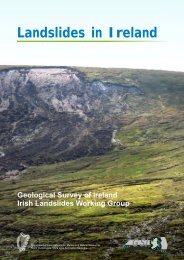PDF Download (2.6Mb) - Geological Survey of Ireland
PDF Download (2.6Mb) - Geological Survey of Ireland
PDF Download (2.6Mb) - Geological Survey of Ireland
You also want an ePaper? Increase the reach of your titles
YUMPU automatically turns print PDFs into web optimized ePapers that Google loves.
Carbon Capture<br />
and Storage (CCS)<br />
John H. Morris<br />
CCS has emerged in recent years as a<br />
technology which has the potential to<br />
contribute very significantly to climate<br />
change mitigation actions by storing CO 2<br />
emissions in underground geological<br />
storage reservoirs, while at the same<br />
time facilitating a global transition towards<br />
lower dependency on consumption <strong>of</strong> all<br />
forms <strong>of</strong> fossil fuels.<br />
The concept is simple: CO 2<br />
is removed<br />
pre-combustion or from exhaust gases<br />
(post-combustion) emitted by major<br />
fossil fuel-powered power stations and<br />
industrial complexes, compressed into<br />
a liquid form and then transmitted by<br />
pipeline or ship to storage sites where it<br />
is injected deep underground into suitable<br />
geological reservoirs. This technology<br />
has been used safely and successfully for<br />
many years by the oil industry, particularly<br />
in the USA, where CO 2<br />
derived from<br />
various sources is injected into depleting<br />
oil reservoirs in order to enhance oil<br />
recovery. It has now been applied and<br />
expanded to encompass a whole new<br />
generation <strong>of</strong> CCS geological reservoirs,<br />
in particular fully depleted oil and gas<br />
fields, as well as deep saline aquifers for<br />
which the theoretical global CO 2<br />
storage<br />
potential is enormous. However, while the<br />
capture and transmission end <strong>of</strong> the CCS<br />
spectrum are reasonable well understood<br />
and developed, the same cannot be said<br />
for the S end – geology – which remains<br />
the least well researched and defined<br />
component, even though the whole CCS<br />
concept is ultimately totally dependent<br />
upon the safe, long term security <strong>of</strong> CO 2<br />
injected into geological reservoirs.<br />
Nonetheless, efforts to achieve full scale<br />
commercial CCS implementations are<br />
now developing very rapidly in many parts<br />
<strong>of</strong> the world, including the USA, Canada,<br />
Australia, China and, not least, in the EU.<br />
Very recently, the EU allocated over €1B<br />
to expedite development <strong>of</strong> a suite <strong>of</strong><br />
“flagship” CCS pilot demonstration plants,<br />
and, in October, announced the names <strong>of</strong><br />
the first 6 <strong>of</strong> these plants. In parallel, the<br />
EU also published its draft directives on<br />
the “<strong>Geological</strong> Storage <strong>of</strong> CO 2<br />
” [which<br />
may be the first time that geology has<br />
featured in the title <strong>of</strong> any EU directive] and<br />
its Emissions Trading Scheme [“ETS”].<br />
<strong>Ireland</strong> has lagged far behind in its efforts<br />
to address, develop and implement this<br />
technology, despite it being one <strong>of</strong> the<br />
largest per capita emitters <strong>of</strong> CO 2<br />
in the EU<br />
as a consequence <strong>of</strong> its major dependency<br />
on fossil fuels. That imbalance is, however,<br />
now starting to be addressed. A study <strong>of</strong><br />
the all-island onshore and <strong>of</strong>fshore CO 2<br />
storage potential, funded by the SEI and<br />
involving various agencies, including GSI<br />
and the <strong>Geological</strong> <strong>Survey</strong> <strong>of</strong> Northern<br />
<strong>Ireland</strong> (GSNI), was published in 2008.<br />
That report, and its recommendations,<br />
provided the framework for three followup<br />
actions:<br />
• an assessment <strong>of</strong> the deep saline<br />
aquifer storage potential in proximity<br />
to Moneypoint, Co. Clare, the single<br />
largest point source CO 2<br />
emitter in<br />
the State. This project, funded by the<br />
EPA and with technical supervision<br />
provided by GSI and PAD, DCENR,<br />
has been completed and will be<br />
published in 2009.<br />
Implementation <strong>of</strong> an all-island<br />
•<br />
cooperative effort to assess and better<br />
•<br />
Geology Matters: Winter 2009<br />
define CO 2<br />
reservoir potential in the<br />
Irish Sea. The Inter-Departmental<br />
CCS Committee chaired by DCENR<br />
mandated the GSI to implement this<br />
project in 2009 jointly with the British<br />
<strong>Geological</strong> <strong>Survey</strong> (BGS) and GSNI.<br />
Current efforts focus upon collation<br />
and integration <strong>of</strong> all pertinent data<br />
from all jurisdictions into a single<br />
digital data structure.<br />
On foot <strong>of</strong> an SEI initiative, preparation<br />
and submission <strong>of</strong> a research proposal<br />
to the EU FP7 programme for funding<br />
to enhance research and knowledge<br />
to advance commercialisation <strong>of</strong><br />
the CCS potential <strong>of</strong> the Kinsale<br />
Head gas field. The Irish partner<br />
group includes PSE Kinsale Energy<br />
Ltd, operators <strong>of</strong> the Kinsale Head<br />
Field, the ESB, UCD and GSI/SEI/<br />
PAD. A preliminary decision on that<br />
application is expected in December<br />
2009.<br />
page 13

















